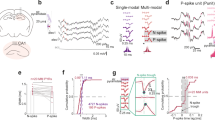Abstract
Although much is known about the morphology and physiology of thalamic neurones1, no information is available regarding the ionic basis for the electrical excitability of these cells. Furthermore, possible differences in the electrical properties of the principal nerve cells in the various thalamic groups have not been studied in sufficient detail to determine whether the thalamus is, electrophysiologically, a uniform set of neuronal elements. Here we present evidence that thalamic neurones have voltage-sensitive ionic conductances capable of generating two distinct functional states—a repetitive and a burst-firing mode. The neurones are switched from one state to the other by membrane potential changes, each state being dominated by different voltage-dependent ionic conductances. At membrane potentials more positive than −60 mV, the neurones respond to a depolarization with repetitive firing via Na+dependent action potentials, whereas at potentials more negative than −65 mV, depolarization of the cell results in short bursts of action potentials via an inactivating all-or-none Ca2+-dependent spike. This property, present in all the neurones comprising the different thalamic nuclei, serves as the basis for their oscillatory properties. Particularly, the inactivating Ca2+ conductance represents the ionic basis for the post-anodal exaltation, the mechanism most probably responsible for the alpha rhythm.
This is a preview of subscription content, access via your institution
Access options
Subscribe to this journal
Receive 51 print issues and online access
$199.00 per year
only $3.90 per issue
Buy this article
- Purchase on Springer Link
- Instant access to full article PDF
Prices may be subject to local taxes which are calculated during checkout
Similar content being viewed by others
References
Shepherd, G. D. The Synaptic Organization of the Brain, 2nd edn (Oxford University Press, New York & Oxford, 1979).
Llinas, R. & Sugimori, M. J. Physiol. Lond. 305, 171–195 (1980).
Granit, R. Mechanisms Regulating the Discharge of Motoneurons (Charles C. Thomas, Illinois, 1972).
Fulton, B. P., Miledi, R. & Takahashi, T. Proc. R. Soc. B208, 115–120 (1980).
Llinas, R. & Yarom, Y. J. Physiol., Lond. 315, 549–567 (1981).
Schwartzkroin, P. A. Brain Res. 85, 423–436 (1975).
Connor, J. A. & Stevens, C. F. J. Physiol., Lond. 213, 21–30 (1971).
Narahashi, T., Moore, J. W. & Scott, W. R. J. gen. Physiol. 47, 965–974 (1964).
Baker, P. F., Hodgkin, A. L. & Ridgway, E. G. J. Physiol., Lond. 218, 709–755 (1971).
Kostyuk, P. G. & Krishtal, O. A. J. Physiol., Lond. 270, 545–568 (1977).
Hagiwara, S. Adv. Biophys. 4, 71–102 (1973).
Llinas, R. & Yarom, Y. J. Physiol., Lond. 315, 569–581 (1981).
Purpura, D. P. & Cohen, B. J. Neurophysiol. 25, 621–635 (1962).
Maendly, R. et al. J. Neurophysiol. 46, 901–917 (1981).
Andersen, P., Ecclcs, J. C. & Sears, T. A. J. Physiol., Lond. 174, 370–399 (1964).
Author information
Authors and Affiliations
Rights and permissions
About this article
Cite this article
Llinás, R., Jahnsen, H. Electrophysiology of mammalian thalamic neurones in vitro. Nature 297, 406–408 (1982). https://doi.org/10.1038/297406a0
Received:
Accepted:
Issue Date:
DOI: https://doi.org/10.1038/297406a0
This article is cited by
-
Neocortical localization and thalamocortical modulation of neuronal hyperexcitability contribute to Fragile X Syndrome
Communications Biology (2022)
-
Thalamic subnetworks as units of function
Nature Neuroscience (2022)
-
An electrophysiological perspective on Parkinson’s disease: symptomatic pathogenesis and therapeutic approaches
Journal of Biomedical Science (2021)
-
Two dynamically distinct circuits drive inhibition in the sensory thalamus
Nature (2020)
-
Unique cysteine-enriched, D2L5 and D4L6 extracellular loops in CaV3 T-type channels alter the passage and block of monovalent and divalent ions
Scientific Reports (2020)
Comments
By submitting a comment you agree to abide by our Terms and Community Guidelines. If you find something abusive or that does not comply with our terms or guidelines please flag it as inappropriate.



